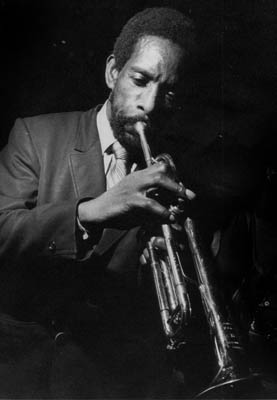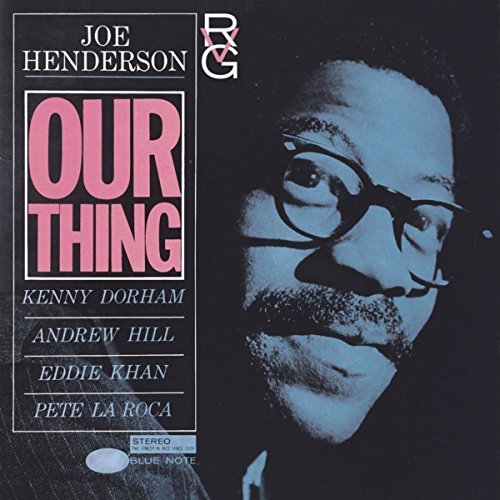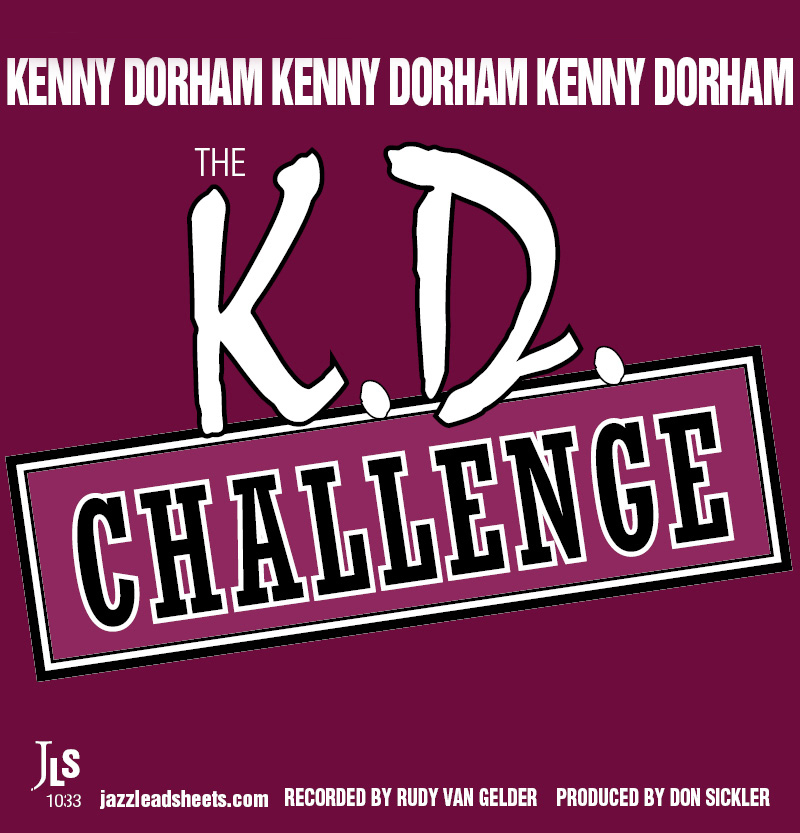Back Road – Kenny Dorham
With its bluesy melody and rhythm section stop-time, this song is quintessential K.D. and deserves to be more widely known. Second parts from the Joe Henderson/Kenny Dorham book are available, plus our K.D. Challenge version has Minus You tracks for all instruments.
- Recording: Joe Henderson - Our Thing
- Recorded on: September 9, 1963
- Label: Blue Note (BLP 4152)
- Concert Key: F minor
- Vocal Range: , to
- Style: Swing (medium)
- Trumpet - Kenny Dorham
- Tenor Sax - Joe Henderson
- Piano - Andrew Hill
- Bass - Eddie Khan
- Drums - Pete La Roca
0:00
0:00
Buy MP3
Video
- Description
- Historical Notes
- Solos
- Piano Corner
- Bass Corner
- Drum Corner
- Guitar Corner
- Inside & Beyond
- Minus You
This catchy medium swinger is a classic example of Kenny's use of stop-time as a communication between the horns and rhythm section, with tutti rhythm section figures, as well as individual roles. Here the horns begin the melody with a three-beat pickup, answered by two rhythm section hits as in Moanin'. Also, as with that song, the melody of Back Road uses the blues scale throughout—in this case over changes that frequently wind up and down with half-step root motion. For the melody, the bridge of the 24-measure AAB form has a marching quarter-note groove, indicated as "blues march" on the lead sheet.
The solo form is its own work of art. It's also AAB (24-measures), but expanded to a two-chorus format for each soloist. The first chorus's distinctive A section rhythm section pattern [excerpt] is doubled up in energy for the second chorus A section [excerpt}.
The solo changes for the A section are also different from the melody: dominant chords mostly moving in fourths. The rhythm section A section figures are essentially a conversation between bass notes and piano chords, alternating once within each measure on the first chorus, and twice on the second. This gives the soloist an added rhythmic layer to work with, breaking up the swing 4-feel time which returns on the bridge.
Transcriptions of Kenny Dorham's and Joe Henderson's solos will soon be available. Click on the second album cover for our "K.D. Challenge" version which has Minus You audio tracks, perfect to help you master this Dorham composition. The lead sheets available there are identical to the ones listed here.
The solo form is its own work of art. It's also AAB (24-measures), but expanded to a two-chorus format for each soloist. The first chorus's distinctive A section rhythm section pattern [excerpt] is doubled up in energy for the second chorus A section [excerpt}.
The solo changes for the A section are also different from the melody: dominant chords mostly moving in fourths. The rhythm section A section figures are essentially a conversation between bass notes and piano chords, alternating once within each measure on the first chorus, and twice on the second. This gives the soloist an added rhythmic layer to work with, breaking up the swing 4-feel time which returns on the bridge.
Transcriptions of Kenny Dorham's and Joe Henderson's solos will soon be available. Click on the second album cover for our "K.D. Challenge" version which has Minus You audio tracks, perfect to help you master this Dorham composition. The lead sheets available there are identical to the ones listed here.
"Our Thing" was recorded at the legendary Rudy Van Gelder Studio in Englewood Cliffs.
Kenny Dorham and Joe Henderson recorded together on six albums, all on Blue Note and recorded within a year and a half. "Our Thing" was the third, after Kenny's "Una Mas," which was Joe's first studio recording, and "Page One," Joe's first album as a leader. On these albums plus Joe's "In 'n Out" and Kenny's "Trompeta Toccata," all the songs on the original album releases were written by either Henderson or Dorham.
Saxophonist Ari Ambrose has recently recorded his own version: Retrospect.
Kenny Dorham and Joe Henderson recorded together on six albums, all on Blue Note and recorded within a year and a half. "Our Thing" was the third, after Kenny's "Una Mas," which was Joe's first studio recording, and "Page One," Joe's first album as a leader. On these albums plus Joe's "In 'n Out" and Kenny's "Trompeta Toccata," all the songs on the original album releases were written by either Henderson or Dorham.
Saxophonist Ari Ambrose has recently recorded his own version: Retrospect.
Joe Henderson CLIP and Kenny Dorham CLIP solo for two choruses each, or once through the two-chorus cycle of rhythm section figures. Transcriptions for these solos are available in B♭ and C editions. Both of these solos are quintessential examples of the poetic, blues-infused style that Joe and Kenny shared. Every idea is crystal clear, and there are many lines in these solos that could easily be the themes of their own songs.
Note that in all our tenor sax solo transcriptions, the C edition is transposed down a whole step from the B♭—written an octave above where it sounds.
Note that in all our tenor sax solo transcriptions, the C edition is transposed down a whole step from the B♭—written an octave above where it sounds.
Related Songs
Email Send Back Road to a friend
Send this page to a friend via email. Add your name or email in the first field. In the second, add one or more email addresses, separated by a comma.
- Recording: Don Sickler - The K.D. Challenge
- Recorded on: October 6, 2001
- Label: jazzleadsheets.com (JLS 1033)
- Concert Key: F minor, No key center
- Vocal Range: , to
- Style: Swing (medium)
- Trumpet - Don Sickler
- Alto Sax - Bobby Porcelli
- Piano - Cecilia Coleman
- Bass - Tim Givens
- Drums - Vince Cherico
Video
- Description
- Historical Notes
- Solos
- Piano Corner
- Bass Corner
- Drum Corner
- Guitar Corner
- Inside & Beyond
- Minus You
Our "K.D. Challenge" version of Back Road is slightly faster than the original recording, but arranged in the same way. The solos are again two choruses each, with the two sets of rhythm section figures indicated on the parts as 1 and 2.
Due to the rhythm section stop-time activity in the head, we consider it important for the pianist, bassist and drummer to know what the other rhythm section members are doing, especially if playing with one of the Minus You rhythm section tracks. Accordingly, in all three rhythm section parts we have also included the melody on a separate. smaller upper staff, and we've written any notable figures below the lower staff that one instrument in the rhythm section has but another does not. In the melody parts, rhythm section figures are also notated under the staff; this is particularly important for this song as the rhythm section is not playing at the beginning of the melody.
Note that the lead sheets available here are the same as the ones under the Henderson album cover. They function as both regular melody lead sheets and as parts for the Minus You tracks. Second parts, as played by Joe Henderson and Kenny Dorham on "Our Thing," can be purchased under the "Our Thing" album cover.
To learn why we think Kenny Dorham's music is so important, click About The K.D. Challenge.
Due to the rhythm section stop-time activity in the head, we consider it important for the pianist, bassist and drummer to know what the other rhythm section members are doing, especially if playing with one of the Minus You rhythm section tracks. Accordingly, in all three rhythm section parts we have also included the melody on a separate. smaller upper staff, and we've written any notable figures below the lower staff that one instrument in the rhythm section has but another does not. In the melody parts, rhythm section figures are also notated under the staff; this is particularly important for this song as the rhythm section is not playing at the beginning of the melody.
Note that the lead sheets available here are the same as the ones under the Henderson album cover. They function as both regular melody lead sheets and as parts for the Minus You tracks. Second parts, as played by Joe Henderson and Kenny Dorham on "Our Thing," can be purchased under the "Our Thing" album cover.
To learn why we think Kenny Dorham's music is so important, click About The K.D. Challenge.
"The K.D. Challenge" was recorded at the legendary Van Gelder Studio in Englewood Cliffs.
Note from Don Sickler: Bobby Porcelli and I have been playing this composition together for many years, I think since the 1970s. Bobby has always been one of my favorite alto players, and this was one of our favorite compositions to play. I remember always letting him take the first solo on this one. Every time we played it he came up with a new fresh approach and really inspired me. Bobby and I started playing with Cecilia, Tim and Vince as a trio much later, but it was still in the last century!
Note from Don Sickler: Bobby Porcelli and I have been playing this composition together for many years, I think since the 1970s. Bobby has always been one of my favorite alto players, and this was one of our favorite compositions to play. I remember always letting him take the first solo on this one. Every time we played it he came up with a new fresh approach and really inspired me. Bobby and I started playing with Cecilia, Tim and Vince as a trio much later, but it was still in the last century!
The melody of Back Road begins with a call and response between the horns and the rhythm section. Drummer Vince Cherico doesn't play any set ups or fills during these A sections; he plays the hits only, giving the melody room to breathe. The B section goes into a march-like 4-feel with some melodic figures you can set up.
Click here to learn more about "The K.D. Challenge" recordings and be sure to check out the rest!
Click here to learn more about "The K.D. Challenge" recordings and be sure to check out the rest!
Another superb Kenny Dorham composition! Separate parts for each rhythm section member.
[ex] Here is an excerpt of our full recorded exclusive audio track. The format of this recording is essentially the same as the original Joe Henderson version:
-- melody
-- sax solo 2 choruses (1 and 2) [different rhythm section figures, see Description]
-- trumpet solo 2 choruses (1 and 2)
-- piano solo 2 choruses (1 and 2)
-- out melody
-- coda
The piano solo choruses are not in the Minus Melody version.
clip] minus melody
-- count off sets up the melody
-- play the melody
-- solo 4 choruses: rhythm section plays figures 1, 2, 1, 2
-- play the out melody and coda
[clip] minus piano
-- count off sets up the melody
-- play figures for the melody
-- play figures/comp for the alto sax solo and trumpet solo:
2 choruses each, alternating figures 1 and 2
-- solo 2 choruses over bass and drums playing figures 1 and 2
-- play figures for the out melody and coda
[clip] minus bass
-- count off sets up the melody
-- play figures for the melody
-- play figures/walk for the alto sax, trumpet, and piano solos:
2 choruses each, alternating figures 1 and 2
-- play figures for the out melody and coda
[clip] minus drums - sticks throughout
-- count off sets up the melody
-- play figures for the melody
-- play figures/comp for the alto sax, trumpet, and piano solos:
2 choruses each, alternating figures 1 and 2
-- play figures for the out melody and coda
clip bass and drums only - to feature piano, guitar, vibes, or any melodic instrument that likes to play without harmonic accompaniment
-- count off sets up the melody
-- play the melody
-- solo 4 choruses: rhythm section plays figures 1, 2, 1, 2
-- play the out melody and coda
[ex] Here is an excerpt of our full recorded exclusive audio track. The format of this recording is essentially the same as the original Joe Henderson version:
-- melody
-- sax solo 2 choruses (1 and 2) [different rhythm section figures, see Description]
-- trumpet solo 2 choruses (1 and 2)
-- piano solo 2 choruses (1 and 2)
-- out melody
-- coda
The piano solo choruses are not in the Minus Melody version.
clip] minus melody
-- count off sets up the melody
-- play the melody
-- solo 4 choruses: rhythm section plays figures 1, 2, 1, 2
-- play the out melody and coda
[clip] minus piano
-- count off sets up the melody
-- play figures for the melody
-- play figures/comp for the alto sax solo and trumpet solo:
2 choruses each, alternating figures 1 and 2
-- solo 2 choruses over bass and drums playing figures 1 and 2
-- play figures for the out melody and coda
[clip] minus bass
-- count off sets up the melody
-- play figures for the melody
-- play figures/walk for the alto sax, trumpet, and piano solos:
2 choruses each, alternating figures 1 and 2
-- play figures for the out melody and coda
[clip] minus drums - sticks throughout
-- count off sets up the melody
-- play figures for the melody
-- play figures/comp for the alto sax, trumpet, and piano solos:
2 choruses each, alternating figures 1 and 2
-- play figures for the out melody and coda
clip bass and drums only - to feature piano, guitar, vibes, or any melodic instrument that likes to play without harmonic accompaniment
-- count off sets up the melody
-- play the melody
-- solo 4 choruses: rhythm section plays figures 1, 2, 1, 2
-- play the out melody and coda
Related Songs
Email Send Back Road to a friend
Send this page to a friend via email. Add your name or email in the first field. In the second, add one or more email addresses, separated by a comma.

Kenny Dorham
August 30, 1924 – December 15, 1972
August 30, 2025, is Kenny Dorham's 101st birthday: jazzleadsheets.com has added many new K.D. compositions. Jazz At Lincoln Center has dedicated three late-night sets to Kenny's music, played with love by young musicians who want his music to live on. Join in, play K.D. music! Read more...
There was a problem.
...


